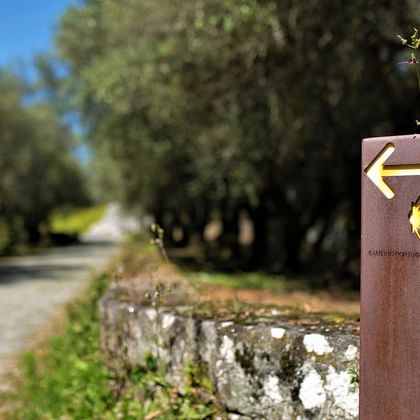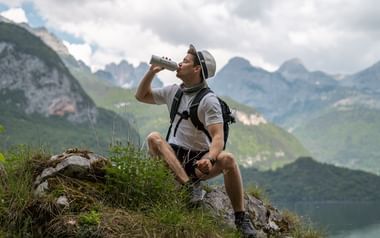On our second day in Spain, we ended up in the town of Oia, which we both fell in love with. The town, which is beautifully situated by the sea, consists of a number of small houses and a large monastery, Santa Maria de Oia, which is a former Cistercian monastery founded in 1137. We stayed in Oia for one night, but could easily have spent another day. So one of the considerations when booking a Camino journey is definitely to include a rest day along the way. Oia would be one of our favourites.
We spent some time on each walking day getting stamps in our Camino passports. The first few days we went
"all-in" and got a lot of stamps. Then we started thinking that there should be room for all of them in our "little book", and subsequently limited ourselves to two stamps a day, which is the minimum if you want your Compostella certificate in Santiago when the Camino ends. It was great fun looking for good places to get stamps. We often chose to visit the local churches. Some of them had stamps, and it also gave us the opportunity to experience the history and culture of the area.
As the days went by, the basic form got better and better. As we walked 28 kilometres a day on our
8th day of walking towards the larger city of Vigo, we talked about how easy it felt. Vigo was the biggest city we came to in Spain besides Santiago. In Vigo, for the first time on the trip, we walked through some "shady" industrial neighbourhoods, and thought that we wanted to get through it very quickly. But it was only a little over an hour. Then we were back in a safer and more urban setting. But we agreed that small towns were the best for us. We almost got a little stressed when we had to spend the night in the centre of Vigo and had to deal with big city traffic and lots of people.
The last few days of walking towards Santiago de Compostela brought together many different Camino routes, and suddenly we felt like we were part of a large group heading towards the same destination. Very different from both Portugal and the first days in Spain, where we could walk many kilometres without meeting others. There were also on this part of the route many more small stalls along the roads with souvenirs and cold drinks. So it was easy to see that this part of the route was "close to the finish". The signage also became much more visible the last 100 kilometres before Santiago. We had no problems at all on the route finding our way. Everything was well signposted and the app from Bering Travel was also very accurate. But in the last few days, there were really many clear indications of how many kilometres were left to the finish.
On the last evening before we had to walk towards Santiago, we were both gripped by a little sentimentality. A little sadness that now the journey was coming to an end. At the same time, we were also looking forward to standing in the square in front of the cathedral together with the many other hundreds of walkers who would enter the same day as us.
We stayed that night in an old monastery that had been converted into a hotel. Very beautiful and with a small chapel neighbouring our room. It was a great way to spend the night before a 30 km hike and 500 metres of altitude the next day. Unfortunately, I woke up with a stomach ache and the journey to Santiago was not without complications. By post-rationalisation, I had paid the day before with notes and received coins in the many street stalls along the route. At the same time, I had eaten well from a bag of nuts I had in my bag. A classic mistake that had given me a stomach virus, which plagued me somewhat on the many kilometres to Santiago, which were covered in almost 40 degree heat. Despite this, it was impossible not to be thoroughly moved the first time the towers of the cathedral in Santiago appeared on the horizon, and late in the afternoon we were in the small streets leading into the square where all the pilgrims gathered. Some sitting alone, quietly looking at the cathedral and the many people, others in the embrace of other pilgrims they had met on their journey. All in all, the square is one big "party". A group of young people celebrated with wine and embraces, and in the middle of it all, a young man in the group got down on one knee for his girlfriend and proposed to her. For them, the end of the Camino is guaranteed to be a memory for life.
The next day we went down and queued to get our Compostella. The proof that we had walked the many kilometres. As we stood in the queue waiting for our number to appear on the board, a tear came to the corner of both our eyes. It was just huge. Both that we had walked so far, that we had done it together, and now we were standing here. Afterwards we went to mass in the cathedral at 12 noon. You have to arrive in good time, about an hour before. It's a beautiful and moving experience that's worth taking with you. Even if it's all in Spanish. As an added bonus, we saw a giant incense burner - El Botafumeiro - set in motion and come "flying" out along the pews. The tradition of using the incense burner, which weighs 53 kg, is 1½ metres high and can reach speeds of up to 70 km/h, is that in the Middle Ages when pilgrims came in after a long journey of watering, they didn't smell very good. Therefore, the church acquired a huge censer to help alleviate the odours. Today, the censer is only used symbolically, but it's still impressive to see it whizzing at high speed 20 metres up in the church.
We were glad we had a full day in Santiago before heading back to Denmark. Many of the other walkers we had met on the trip were going home the day after they had reached the finish line. We all agreed that would have stressed us out a bit. Now we strolled quietly around the streets, did a little shopping and mentally began to look towards the journey home.






